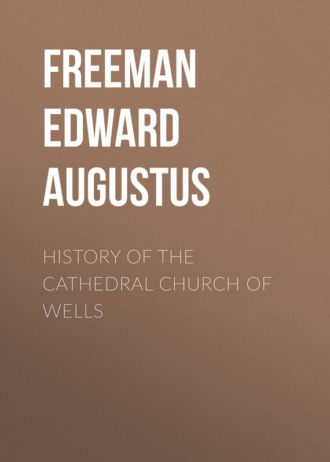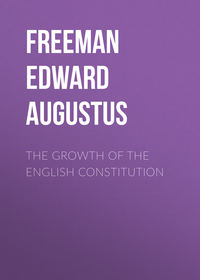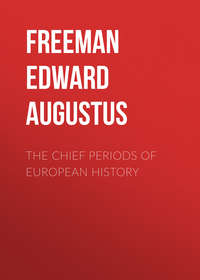 полная версия
полная версияHistory of the Cathedral Church of Wells
If we turn to the east end, we shall, as I have already said, find the church of Wells holding a far higher position among its fellows. The east ends of English churches are of various kinds; the apsidal form, that most usual on the Continent, being the rarest. We do indeed find the German apse without aisles repeated at Lichfield, and the French apse with its divergent chapels is found on a vast scale at Westminster, and on a smaller at Tewkesbury. And there are a few other examples of apses of less merit and importance at Pershore, Coventry, Wrexham, and a few other places.123 But the apsidal arrangement never was thoroughly English. Of the three great examples Tewkesbury is the only one where the apse fills its proper function of a canopy over the high altar. At Westminster the high altar is displaced by the shrine of Eadward the Confessor, and at Lichfield it is not the choir, but a Lady chapel of the full height, of which the apse is the ending. English east ends fall for the most part under two classes. Sometimes, as at York, Lincoln, Ely, Beverley, and Southwell, the Lady chapel and whatever else stands east of the high altar is carried on at the full height of the church. In other cases, as at Winchester, Hereford, Exeter, and Salisbury, the Lady chapel and other chapels east of the choir are much lower than the main body of the church. Now of these arrangements I confess that I myself prefer the apse to all others. No other plan gives such dignity to the high altar, or makes it so evidently the central and crowning point of the whole church. There is undoubtedly great stateliness in such an arrangement as that of York and Lincoln; but its good effect is almost wholly confined to the outside. The high altar seems to have come where it is by accident; its position is marked by a mere screen, not by anything in the arrangement of the building itself. In the third arrangement, where all that is east of the choir is much lower than the choir, some share of its proper dignity is or may be restored to the high altar. But, on the other hand, it is not easy to add on a lower building which shall be in full harmony with the loftier parts of the church. There is something insignificant about the Lady chapel at Salisbury, and it is hard to admire, externally at least, the long masses of low chapels at Winchester and Saint Alban's. A happy accident, as I have already explained, gave the opportunity at Wells of producing a form of east end which I think certainly surpasses all others of its class. The general outline and proportion of the church are no less excellent, and it is fortunate in having had everything finished, and in having nothing destroyed. At Hereford, as I have already said, the western tower has vanished, and it has carried part of the nave away with it. But, even while it stood, the single western tower could never have grouped so well with the central lantern as the two western towers at Wells. Wimborne, the chief surviving example of this arrangement, I have heard irreverently compared to driving tandem, and I cannot deny the aptness of the saying.124 At Southwell, where the grouping of the three towers is as perfect as it well may be, the general effect has greatly suffered by the lowering of the roofs throughout. We shall hardly venture to compare the four limbs of Wells with the four limbs of Beverley, but of the Beverley west front I have already spoken, and the general effect of the church is altogether ruined through the central tower never having been carried up. Even at Lichfield, the faultless grace of the three spires, even the loveliness of the apse, cannot reconcile us to the long low body and to the extravagant length of the eastern limb. The eastern view of Lichfield, graceful as it is, cannot compare with the real stateliness of the east end of Wells. I have seen many fine churches both in our own country and abroad, many of them of course on a scale which might seem to put Wells out of all comparison. But I can honestly say that I know of no architectural group which surpasses the harmony and variety of our own cathedral, as seen by the traveller as he first enters the city from Shepton Mallet.
From the outside we turn to that of which the outside is after all the mere shell. When we enter the church, we find ourselves in a building which can fairly hold its own against competitors of its own class. The nave has a distinct character of its own: there may be differences of taste as to its merit, but it has a character, and that character is clearly the result of design. The main lines of the interior are horizontal rather than vertical. We can hardly say that there is any division into bays; no vaulting-shafts run up from the ground, nor does the triforium take, as usual, the form of a distinct composition over each arch. In short we cannot, as we can in most churches, take each arch with the triforium and clerestory over it as a thing existing by itself. One would rather say that three horizontal ranges, one over the other, all converged to the centre, without thinking of what was above or below them. Now tastes may differ as to whether this is a good arrangement or not, but there is no doubt that it is in its way an effective arrangement; there is no nave in which the eye is so irresistibly carried eastward as in that of Wells. And it is worth notice that this arrangement, in its fulness, is confined to the nave; in the transepts the bays are much more clearly marked. The idea of producing this marked horizontal effect was clearly one which came into the heads of the designers as they were working westwards.
It might have been expected that the marked prominence which is thus given to the horizontal line might have gone far to destroy all effect of height in the interior; but it is not so. There is no special feeling of height in Wells Cathedral – not so much, for instance, as there is in the church of Saint Mary Redcliff; but there is no such crushing feeling of lowness as there is at Lincoln. This I imagine to be mainly owing to the form of the arch chosen for the vaulting, one boldly but not acutely pointed, and to the way in which the lantern-arches fit into the vault. Contrast this with the far larger and loftier nave of York. In that nave the positive height is second only to Westminster among English churches, and the design of the separate bays can hardly be surpassed in its soaring effect. But in the direct eastern or western view the nave of York loses almost its whole effect, partly, no doubt, from the excessive breadth, but partly also from the flat and crushing shape of the vaulting-arch. Another point which I think helps to redress the balance between horizontal and vertical effect is the great height of the clerestory. In a church where the vertical bays are strongly marked I do not think that great comparative height in the clerestory helps to increase the effect of height. But in such cases the question rather lies between the arcade as one thing, and the triforium and clerestory together as another. Here the question lay between the triforium and the clerestory, and I cannot help thinking that, if the triforium had been on the same scale as that in the choir of Ely, the effect of height would have been less. At any rate, the nave of Wells makes the most of its small actual height: so do the choir and presbytery also; for, though I cannot at all admire the kind of vault which is there used, the shape of the arch is as judiciously chosen as it is in the nave. In the presbytery we also get the vaulting-shafts rising from the ground, so as to give the vertical division, and the consequent effect of height, in its highest perfection. Of the exquisite beauty of the Lady chapel, looked on, as it should be, not as a part of the whole, but as a distinct and almost detached building, I have already spoken. In short, the internal effect of the church, whether looked at as a whole or taken in its several parts, if not of the highest order, which its comparatively small scale forbids, may claim a high place among churches of its own class.
I think then on the whole that, even looking at the church by itself, we have every reason to be thankful for what we have got. We have not a church of the first order; but we have a church whose several parts fit very well together, all whose parts have been finished, and of which no part has been destroyed. And I may add that we may be thankful for another thing, for the goodness of the stone of which the greater part of the church is built. The sculpture of the west front indeed has crumbled away; but elsewhere at Wells, as at Glastonbury, wherever the work has not been wantonly knocked away, it is as good as when it was first cut. Now we might have had a church like Chester or Coventry, where the whole surface of the stone has crumbled away, and where the whole ornamental design has become unintelligible. I have said that the church of Wells forms a harmonious whole, that it was perfectly finished, and that no part has been destroyed; and this is a great thing to say. Let me compare the good fortune of Wells in this respect with the cathedral church of a much more famous city at the other end of England. At Carlisle there is a noble choir, ending in what is probably the grandest window in England. If that choir only had transepts, nave, and towers to match it, the church of Carlisle would be a splendid church indeed. But the choir is built up against a little paltry transept and central tower, and nothing remains by way of nave but two bays of the original small Norman church, the rest having utterly vanished. Here then is a church which does not form a harmonious whole, a church which remains utterly unfinished, and of which one essential part has been destroyed. Or, without taking such an extreme case as this, we may compare our church with some of those of which I have already spoken, with Hereford, Southwell, Beverley, and Tewkesbury. In all of these some important feature has either never been finished or has been destroyed at a later time. The church of Wells then, simply taken by itself, claims a high place among buildings of its own class, that is, among minsters of the second order. But, as I began these lectures by saying, the real charm of Wells does not lie in the church taken by itself, but in the church surrounded by its accompanying buildings. Of some of these I must now speak a word. I do not intend to go minutely into either their architecture or their history; but some of them are inseparably connected both with the fabric and with the foundation of the cathedral. And it is the preservation of them which gives Wells its peculiar character. Each part may easily be equalled or surpassed, but the whole has no rival in England, and I cannot think that it has many in Christendom.
It was during the fourteenth and fifteenth centuries, alongside of the works in the church itself of which I have already spoken, that those subordinate buildings were also rising, which have given Wells this its peculiar character as the most complete and most uninjured example of the buildings of a great secular foundation. The greatest name in this way in the course of the fourteenth century is one which we all know, that of Bishop Ralph of Shrewsbury; I have already spoken of him as having probably had a chief hand in the reconstruction of the choir and presbytery. He also gave the palace its present form. The house had been originally built by Jocelin. The great hall had been added by Robert Burnell. It was Ralph who fenced himself in with a moat and a wall as we now see.125 But his greatest work is to be looked for on the other side of the church, and it is closely connected with the constitutional change which may be looked on as putting the finishing stroke to the existing constitution of the cathedral, I mean the foundation of the College of Vicars. The great offices of the church were now all in being, and the relations between the two classes of Canons had been pretty well fixed. It now remained to fix the exact position of that subordinate body of clergy which had grown up through the prevalent practice of non-residence among the Canons. The Vicar, we have seen, was at first simply the personal deputy of some particular Canon, appointed by him to discharge his duties in his absence. But it could hardly fail that the Vicars as a body should gradually enter into some sort of relation with the Chapter as a body. This would especially be the case, when residence became the fixed duty of one class of Canons and no part of the duty of another. The Vicars would gradually change from deputies of absent Canons into assistants of Canons who at least professed to be present. As such, it was natural that they should receive a fixed status in the church, and, with the ideas of those times, it was equally natural that they should receive somewhat of corporate independence. The Vicars of Wells then, like the Vicars of most or all of the Old Foundation churches, became a distinct corporation. They were subordinate to the Chapter as regards their duties in the church, but they were independent of it as regards the estates with which they were endowed, and they were governed by statutes given them by their founder. That founder was, as we all know, Ralph of Shrewsbury. Most of you, no doubt, have seen the picture with the Latin verses in which the Vicars set forth their hard case to the Bishop, how they are driven to live where they can about the town, and how he promises to give them a house where they may live together.126 Then arose the Vicars' Close of Wells, and, though the present buildings mainly belong to a later time, yet portions of Ralph's work may still be seen, especially in the hall, where several of his windows still remain. But the complaint of the Vicars, that they were scattered through the streets of the town, deserves notice. In the first state of things, as is plain from the stories told by Richard of the Devizes, the Vicar lived in the house of the Canon whom he represented.127 But it is equally plain that as the number of prebends increased, even the institution of ribs did not provide a house for every Canon, and, as the institution of special Residentiaries became fixed, the available houses would be mainly occupied by them. We can thus understand how there might now be many Vicars unprovided with any place to dwell in. The buildings of the Close were recast and almost rebuilt by the three executors of Bishop Beckington, Richard Swan the Provost, Hugh Sugar the Treasurer, and John Pope, Prebendary of Saint Decumans.128 They were commissioned to dispose of the unbequeathed portion of the Bishop's goods to pious uses at their discretion, and, besides other works in other parts of the diocese, the Vicars' Close now assumed its present shape. In that shape it is certainly without a rival. I know nothing to compare to those two quiet ranges of houses, the hall at one end, the chapel at the other, suggesting the very perfection of collegiate life; and, as an ingenious device for turning a piece of practical convenience into a matter of high architectural ornament, nothing can well surpass the chain-bridge. I need not say that the original design of the institution was at once broken in upon as soon as marriage was allowed to its members. The two rooms, with the separate approach to each, were designed as college rooms for men who took their meals in the common hall; and, as college rooms, they give very far from contemptible accommodation. But they were, of course, utterly unsuited for the reception of wives and families, and the architectural features of the Close have been sadly damaged by throwing two or more houses into one. I have always cherished a sort of dream that, by some means or other, the old institution of the Vicars' College and the new institution of the Theological College might be rolled into one, that the office of Vicar in the cathedral might be held by young clergymen and by men preparing for holy orders, and that collegiate life might be again restored in the old hall of Ralph and Beckington. But, however this may be, I would at least call on the clerical members of the College to stick to their good old title of Priest Vicar, and not to call themselves, or allow themselves to be called, by the new-fangled name of Minor Canon. It is historically incorrect; it was in use at Saint Paul's and at Hereford, but it was never in use at Wells. That it is better sounding or more honourable than that of Priest Vicar I cannot believe. To me it seems exactly the reverse, as the stress is always laid on the word Minor, never on the word Canon. And it tends to confound the Priest Vicars of our Old Foundations with men holding a position very inferior to theirs, namely the Petty Canons or Minor Canons of the churches founded by Henry the Eighth. These are simple subordinates of the Chapter, without any separate endowment or corporate independence of any kind. The supposed legal necessity for the change arises from a misconstruction of an Act of Parliament, which really orders nothing of the kind. To hear of a Minor Canon of Wells is as bad as to hear of an Honorary Canon; that is to say, to hear a Canon or Prebendary of Wells, whose stall dates perhaps from the twelfth century, pulled down to the level of those mysterious personages, not only without revenues but without either rights or duties, who have sprung up at Bristol or Manchester within the present reign.
The history of Vicars' Colleges at Wells and elsewhere should be written in full. No one could do it so well as my friend Mr. Dimock, once himself a Priest Vicar of the collegiate church of Southwell.129 One point to be worked out with special care would be the steps and causes by which the office came to be held by laymen. The change in this respect was fully recognized by the charter of Elizabeth, which confirmed the rights and estates of the Vicars, and regulated, without absolutely fixing, the numbers of the two classes of Vicars, clerical and lay. It is a change which has not taken place everywhere. The Vicars at York are still a purely clerical body, the lay members of the choir being mere stipendiaries. And, unless some change has been made very lately, the same is the case at Hereford.130 And as the Priest Vicars of our Old Foundations should never be confounded with the Petty Canons of the New, still less should the lay members of those colleges, equal in corporate rights to their clerical brethren, ever be degraded to the level of the mere lay clerks or singing-men of other churches, who are sometimes simply stipendiaries, and who, even when they are statutable officers, have no separate endowment or corporate being.
There were thus, before the end of the fourteenth century, two distinct corporations attached to the cathedral church, namely, the Chapter and the College of Vicars. These two were and are distinct and independent as regards their property and personal being, though, as regards the duty and discipline of the church, the members of the younger foundation were and are subordinate to the members of the elder. These two bodies still remain, and I trust they may long remain and flourish; but, in the first years of the fifteenth century, a third body arose, which has vanished from among us. We read that Ralph Erghum, who was Bishop from 1388 to 1401, and who was a benefactor to his church in several ways,131 founded by his will a College of fourteen priests in a place which was then called the Mounterye, and which from this foundation took the name of College Lane.132 That is to say, he seems to have incorporated the Chantry-priests of the cathedral, the priests who, besides the public services performed by the Canons and Vicars, said masses for particular persons at particular altars. All foundations of this kind were suppressed by the Act of the first year of Edward the Sixth, and the only memory which Erghum's foundation has left among us is the name which still belongs to the lane.
The separate houses of Canons and other officers belong mainly to the fifteenth century, though there are some portions of earlier date. Let me here especially mention one small and decaying but very beautiful fragment, namely the round window with wooden tracery at the east end of the house which formerly belonged to the Archdeacons of Wells. The house itself, strangely disguised as it is without, contains within a very fine timber roof; the Deanery too, much as it has suffered from the insertion of modern windows, still retains much of the dignity of design which it received from its builder, the learned Dean Gunthorpe, who held the office from 1473 to 1498.133 But I will not enlarge more fully on the particular houses; they are the especial province of Mr. Parker, and he has dealt with them all from the Bishop's palace to the house of the organist.134 I would only again insist on the necessity, on the duty, of carefully preserving every one of these ancient buildings to the assemblage of which our city owes its special position among the cities of England. We have lost too much already. Every year some ancient building is destroyed or threatened.135 Let those whose business it is awake before it is too late; let them see that not another stone is sacrificed to niggardliness, to caprice, or to ignorant notions of improvement. Look, for instance, at what was some time back trumpeted as a vast improvement, the pulling down of a house to open a view of the west front of the Cathedral to the windows of the Swan Inn. The doers of that deed most likely knew not what they were doing. They perhaps did not even remember that, in opening the view of the west front of the Cathedral to the windows of the Swan Inn, they were also opening the not very picturesque view of the Swan Inn to those who came out of the western doors of the Cathedral. They did not stop to think that the space before the west front was really too open already, and that at any rate matters were not mended by opening a view through so ludicrous a gap, which I have heard witty people compare to the space left in a man's mouth by drawing a single tooth. Still less did they think that, in a thoughtless moment of destruction, they were wiping out the whole history of the church and city. The house indeed was in itself valueless; I should not have wept for the removal of the house or of the whole row of houses of which it formed a part. But, along with the house, the destroyers overthrew the wall against which the house was built up, and that wall was the history of the city of Wells. At Wells, as I have already set forth, the church was not founded in the city, but the city grew up under the shadow of the church.136 The church and its precincts were not taken into the city till the days of parliamentary and municipal reform. The wall of the Close is everywhere a sign of separation, marking off ecclesiastical and temporal property, and often marking the limits of distinct jurisdictions. But at Wells the wall has a special significance, as a memorial of the days when the city arose outside the ecclesiastical precinct. Thus, by a single thoughtless act, not only is a material piece of antiquity destroyed, but a page of local, and thereby of national, history is torn away.
The only remaining work to be mentioned is one to which I have incidentally referred more than once, namely, the cloister and the buildings attached to it. I have now to add that the detached Lady chapel in the east walk of the cloister was rebuilt by Robert Stillington, who was Bishop from 1464 to 1487, an event which is best recorded in the words of Bishop Godwin.
"He built that goodly Lady Chappell in the cloysters, that was pulled down by him that destroyed also the great hall of the palace … and was entombed in the said Chappell, but rested not long there: For it is reported, that divers olde men, who in their youth had not onely seene the celebration of his funerals, but also the building of his toombe, Chappell and all; did also see, toombe and Chappell destroyed, and the bones of the Bishop that built them, turned out of the lead in which they were interred."137
This quotation may serve as a fitting transition to the times which we have now reached. We have now done with the age of building up, and we have come to the age of pulling down. At the end of the fifteenth century the church of Wells had reached its highest degree of perfection. The church was complete; its appurtenances were complete. Of the fabric itself it is enough to say that our great Beckington, so bountiful a benefactor to the city and diocese in every other way, did nothing to the actual fabric of the cathedral, because there was really nothing for him to do. My subject, you will remember, is the cathedral church, alike in its fabric and in its constitution. Had my subject been the city generally, I should have found something to say about the parish church, about the hospitals, about the Guild-hall, about Beckington's houses in the marketplace. But I keep myself to the cathedral and its immediate belongings. The destruction spoken of in the extract which I just before made from Godwin carries us on to the reign of Edward the Sixth. But I must first say a few words about the reign of Henry the Eighth. I must now once more call on you carefully to bear in mind the distinction between the regular and secular clergy, and between the cathedral churches served by each of them severally. In the course of the reign of Henry the Eighth all the monastic foundations in England were destroyed. Everybody knows this fact, but everybody does not put the fact in its right place. People talk of an event called the Reformation, as if it were a single event which happened in some one particular year, like the passing of the Reform Bill or the cutting off of Charles the First's head. No such event ever happened. A great many ecclesiastical changes took place in the course of the sixteenth century, but those changes did not happen all at once, and many of them had no immediate connexion with one another. Above all, do not fancy that an old Church was destroyed and a new Church founded; do not fancy that property was taken from one set of clergy and given to another set of clergy. Nothing of the sort ever happened. Great changes were made in the Church of England, changes which, as some people at the time thought, went too far, and which, as other people thought, did not go far enough. But these changes in no way touched what we may call the personal identity of the Church before and after them. Remember that I am not talking theology but history. No one here will suppose that I, of all men, deny the power of Parliament to disestablish and disendow a Church, if it sees good reason to do so; I only say that, as a matter of fact, that power was not exercised by Parliament in the sixteenth century. Certain ecclesiastical changes were made; certain ecclesiastical foundations were suppressed; but the Church itself went on. The throwing off of the authority of the Bishop of Rome, the suppression of the monasteries, the introduction of the English Prayer-Book and Articles, were three different events, which happened at three different times, and which had nothing directly to do with one another. The monastic foundations accepted the King's supremacy just as fully as the secular foundations did, and, after the monasteries were suppressed, mass went on being said in the cathedral, collegiate, and parochial churches, just as it had been before. And let no one fancy that the two suppressions familiar to us in the reign of Henry the Eighth, the suppression of the lesser and of the greater monasteries, were the first cases of the suppression of ecclesiastical foundations known in England. The supreme power of the state in England has in all ages, as it has done in our own day, exercised that authority over the temporalities of the Church, which, in its own nature, it must exercise over everything. Cardinal Wolsey suppressed a number of small monasteries in order to transfer their endowments to his colleges at Ipswich and Oxford.138 Before that, in the reign of Henry the Fifth, the Alien Priories, that is the monasteries which were dependent on monasteries in foreign countries, were suppressed by Act of Parliament.139 The main difference is that in these cases monasteries were suppressed for good political reasons, and their revenues were applied to useful public purposes, while in the suppression under Henry and Cromwell all that was thought of was the scramble of the King and his courtiers for their own private pelf.140 The most sickening havoc and sacrilege ran wild among the noblest and holiest fabrics of the land. We have but to go as far as Glastonbury, to see the desolation of the most venerable spot in Britain, to ask in vain for the burying-places of our Kings and heroes, and to look up to the height where the last Abbot of that great house won the martyr's crown rather than betray his trust and provide for his own enrichment and promotion by wilfully surrendering his church to the illegal bidding of the spoiler.141







